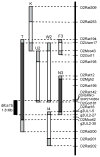Rat Mcs1b is concordant to the genome-wide association-identified breast cancer risk locus at human 5q11.2 and MIER3 is a candidate cancer susceptibility gene
- PMID: 22993404
- PMCID: PMC3500408
- DOI: 10.1158/0008-5472.CAN-12-0748
Rat Mcs1b is concordant to the genome-wide association-identified breast cancer risk locus at human 5q11.2 and MIER3 is a candidate cancer susceptibility gene
Abstract
Low-penetrance alleles associated with breast cancer risk have been identified in population-based studies. Most risk loci contain either no or multiple potential candidate genes. Rat mammary carcinoma susceptibility 1b (Mcs1b) is a quantitative trait locus on RN02 that confers decreased susceptibility when Copenhagen (COP)-resistant alleles are introgressed into a Wistar Furth (WF)-susceptible genome. Five WF.COP congenic lines containing COP RN02 segments were compared. One line developed an average of 3.4 ± 2.0 and 5.5 ± 3.6 mammary carcinomas per rat ± SD when females were Mcs1b-resistant homozygous and Mcs1b heterozygous, respectively. These phenotypes were significantly different from susceptible genotype littermates (7.8 ± 3.1 mean mammary carcinomas per rat ± SD, P = 0.0001 and P = 0.0413, respectively). All other congenic lines tested were susceptible. Thus, Mcs1b was narrowed to 1.8 Mb of RN02 between genetic markers ENSRNOSNP2740854 and g2UL2-27. Mammary gland-graft carcinoma susceptibility assays were used to determine that donor (P = 0.0019), but not recipient Mcs1b genotype (P = 0.9381), was associated with ectopic mammary carcinoma outcome. Rat Mcs1b contains sequence orthologous to human 5q11.2, a breast cancer susceptibility locus identified in multiple genome-wide association studies. Human/rat MAP3K1/Map3k1 and mesoderm induction early response (MIER; MIER3)/MIER3 are within these orthologous segments. We identified MIER3 as a candidate Mcs1b gene based on 4.5-fold higher mammary gland levels of MIER3 transcripts in susceptible compared with Mcs1b-resistant females. These data suggest that the human 5q11.2 breast cancer risk allele marked by rs889312 is mammary gland autonomous, and MIER3 is a candidate breast cancer susceptibility gene.
©2012 AACR.
Conflict of interest statement
Potential conflicts of interest: None.
Figures





Similar articles
-
Rat Mammary carcinoma susceptibility 3 (Mcs3) pleiotropy, socioenvironmental interaction, and comparative genomics with orthologous human 15q25.1-25.2.G3 (Bethesda). 2023 Jan 12;13(1):jkac288. doi: 10.1093/g3journal/jkac288. G3 (Bethesda). 2023. PMID: 36315068 Free PMC article.
-
Congenic rats reveal three independent Copenhagen alleles within the Mcs1 quantitative trait locus that confer resistance to mammary cancer.Cancer Res. 2003 Sep 15;63(18):5808-12. Cancer Res. 2003. PMID: 14522903
-
Physical Confirmation and Comparative Genomics of the Rat Mammary carcinoma susceptibility 3 Quantitative Trait Locus.G3 (Bethesda). 2017 Jun 7;7(6):1767-1773. doi: 10.1534/g3.117.039388. G3 (Bethesda). 2017. PMID: 28391240 Free PMC article.
-
The genetic components of susceptibility to breast cancer in the rat.Prog Exp Tumor Res. 1999;35:158-69. doi: 10.1159/000062012. Prog Exp Tumor Res. 1999. PMID: 10377759 Review.
-
Inherited susceptibility and acquired allelic imbalance in rat mammary carcinogenesis.J Cell Biochem Suppl. 1996;25:37-40. J Cell Biochem Suppl. 1996. PMID: 9027596 Review.
Cited by
-
The gene desert mammary carcinoma susceptibility locus Mcs1a regulates Nr2f1 modifying mammary epithelial cell differentiation and proliferation.PLoS Genet. 2013 Jun;9(6):e1003549. doi: 10.1371/journal.pgen.1003549. Epub 2013 Jun 13. PLoS Genet. 2013. PMID: 23785296 Free PMC article.
-
MIER3 suppresses colorectal cancer progression by down-regulating Sp1, inhibiting epithelial-mesenchymal transition.Sci Rep. 2017 Sep 8;7(1):11000. doi: 10.1038/s41598-017-11374-y. Sci Rep. 2017. PMID: 28887525 Free PMC article.
-
Rat Mammary carcinoma susceptibility 3 (Mcs3) pleiotropy, socioenvironmental interaction, and comparative genomics with orthologous human 15q25.1-25.2.G3 (Bethesda). 2023 Jan 12;13(1):jkac288. doi: 10.1093/g3journal/jkac288. G3 (Bethesda). 2023. PMID: 36315068 Free PMC article.
-
Validation of six genetic determinants of susceptibility to estrogen-induced mammary cancer in the rat and assessment of their relevance to breast cancer risk in humans.G3 (Bethesda). 2014 May 28;4(8):1385-94. doi: 10.1534/g3.114.011163. G3 (Bethesda). 2014. PMID: 24875630 Free PMC article.
-
Mapping of Mcs30, a new mammary carcinoma susceptibility quantitative trait locus (QTL30) on rat chromosome 12: identification of fry as a candidate Mcs gene.PLoS One. 2013 Sep 2;8(9):e70930. doi: 10.1371/journal.pone.0070930. eCollection 2013. PLoS One. 2013. PMID: 24023717 Free PMC article.
References
-
- Samuelson DJ, Hesselson SE, Aperavich BA, Zan Y, Haag JD, Trentham-Dietz A, Hampton JM, Mau B, Chen KS, Baynes C, et al. Rat Mcs5a is a compound quantitative trait locus with orthologous human loci that associate with breast cancer risk. Proc Natl Acad Sci U S A. 2007;104(15):6299–6304. - PMC - PubMed
-
- Stacey SN, Manolescu A, Sulem P, Rafnar T, Gudmundsson J, Gudjonsson SA, Masson G, Jakobsdottir M, Thorlacius S, Helgason A, et al. Common variants on chromosomes 2q35 and 16q12 confer susceptibility to estrogen receptor-positive breast cancer. Nat Genet. 2007;39(7):865–869. - PubMed
Publication types
MeSH terms
Substances
Grants and funding
LinkOut - more resources
Full Text Sources
Medical
Molecular Biology Databases
Miscellaneous

